Months after entering lunar orbit, the Danuri spacecraft from South Korea has transmitted remarkably detailed images of the Moon’s craters.
As it continues to orbit the Moon, the Korea Pathfinder Lunar Orbiter (KPLO) spacecraft operated by the Korea Aerospace Research Institute (KARI) has transmitted four images of the lunar surface. The images disclose not only craters but also features on the Moon’s surface that are covered in regolith (lunar sediment and dust).
In April, the spacecraft transmitted images showing four craters on the Moon: Tsiolkovsky crater, Schrdinger Valley, Wichmann Crater, and Szilard M crater.
On the Moon’s far side, at 128.5 degrees east longitude and 20.5 degrees south latitude, is the Tsiolkovsky crater. The crater was previously photographed by Apollo-13 mission astronauts, who were forced to abort their scheduled lunar touchdown due to an oxygen tank detonation in the Service Module (SM).

Images from the Danuri spacecraft’s high-resolution camera were processed and shared.
In January, the spacecraft transmitted breathtaking images of the Earth emerging behind the crescent Moon. The images were part of the authentication pictures of the lunar heavens captured by the spacecraft’s high-resolution camera (LUTI), which revealed large craters on the Moon’s surface as the probe descended.

KARI has been tasked with conducting lunar observations while traveling just 100 kilometers above the Moon’s surface. This is the first lunar mission for South Korea, which only recently acquired the ability to launch space rockets.
The spacecraft, which cost roughly $180 million to construct, carries six scientific instruments, including a camera for NASA. It is intended to observe the perpetually shadowed, ice-filled craters at the lunar poles.
